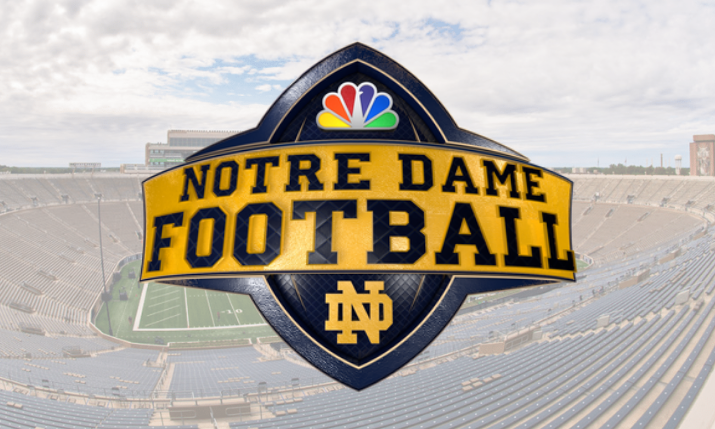NBC Sports Deploys Robust Hybrid At-Home Workflow To Add Championship-Level Resources to Notre Dame-Clemson Matchup
NBC Sports producer Pierre Moossa: 'far and away the biggest production we've ever done in the history of our Notre Dame coverage'
Story Highlights
Between the Breeders’ Cup Classic, the finale of the NASCAR Cup Series, a full slate of Premier League soccer (highlighted by a meeting of the last two champs Liverpool and Manchester City), and the biggest game of the NFL weekend on Sunday Night Football (Saints at Buccaneers), its a big time weekend for NBC Sports.
Yet, despite all those marquee events, the biggest, most notable event from a production and operations perspective may very well be NBC’s broadcast of the juiciest college football showdown of the weekend: No. 1 Clemson visiting No. 4 Notre Dame. A Championship Game level of resources has been deployed both on-site in South Bend and at NBC Sports’ home facility in Stamford, CT in a robust on-site and remote hybrid workflow in what NBC Sports producer Pierre Moossa called “far and away the biggest production we’ve ever done in the history of our Notre Dame coverage.”
 That’s quite the statement for a sports television property that’s been in place for 30 seasons.
That’s quite the statement for a sports television property that’s been in place for 30 seasons.
Intricate Transmission Plan Bolsters Support from Stamford
It’s been a unique season of producing Notre Dame football games and this week is no exception. NBC Sports has been utilizing a hybrid workflow that has announcers, camera operators, and other key technicians on site in South Bend while the primary production truck (NEP Broadcasting’s ND6) running the show is stationed in a parking lot outside the network’s Stamford facility where positions like replay operators, graphics, and research are working inside.
There are even some crew members working from their actual homes, including the operator of the Pylon Cams, which are appearing on an NBC Notre Dame broadcast for the first time this season.
In order to support this vast network of contributors to the live show, NBC’s technical and operations teams are relying on the years worth of learnings that have come as a result of broadcasting in a COVID world and combined it with its many years of Olympics experience which leverages workflows of a similar nature.
In South Bend, NEP’s NCP 11 is parked at Notre Dame Stadium but is largely serving as a transmission hub to send a wealth of direct feeds back to Stamford. According to Jenny Powelson, Remote Tech Manager for NBC Sports Group (who is on site in South Bend), there are forty transmission paths flowing from South Bend to Stamford with 30 of them being 1080p HDR paths like camera feeds and replay sources. There are also ten 1080i SDR paths carrying feeds from POVs, resources shared by Notre Dame’s Fighting Irish Digital Media division, and a router paths for the show’s TD to be able to call up multiple sources.
Additionally, nine feeds transmit out of Stanford, eight which, come to Notre Dame and two of which go out to broadcast hubs. There’s an added HDR transmission path to support the high-dynamic range version of the game (which is being overseen in a separate truck in Stamford by Sports Broadcasting Hall of Famer and NBC Sports’ Senior Vice President and Chief Technical Officer Dave Mazza). Seven of the feeds also that come here to South Bend, but… And monitor feeds for talent.
“We’re basically at the end of the highway when it comes to bandwidth,” laughs Powelson. “We’re using it all.”
The complex operation has the NBC Sports team ready to pull off a pretty unique production headed up by industry vets like Senior Vice President, Remote and Studio Operations Ken Goss, Vice President, Remote Technical Operations and Engineering Craig Bernstein, and Director of Production, Engineering and Technology Michael Drazin.
“[This is] one of the most ambitious and complicated production technical plans that I have ever taken part in [at NBC],” says Moossa. “Obviously, the success of it is really a tribute to our entire technical team.”
Expanding the Camera Coverage for Replay
While NBC Sports has been utilizing that hybrid production model all season for its Notre Dame Football coverage, this week’s game is getting an extra level of TLC that includes a widely expanded camera deployment that Moossaa says resembles more of an NFL playoff game than a regular season college football game. Saturday’s broadcast will feature seven 6X-super-motion cameras and a set of 4K cameras on each of the goal lines and down each of the sidelines. Most of these added resources, Moossa says, are in place to bolster the production team’s replay capabilities.
“We have a responsibility to document the game in addition to providing the best possible coverage for viewers,” says Moossa. “Ultimately the replay for the referees are based on the replays we show. So, if there is a defining play, whether it’s crossing the goal line or foot inbounds, or whether it was a fumble or a knee down, all those things, how we document the game could determine the outcome of whether the referee sees a defining look.”
Moossa was also clear that the front bench will remain true to their commitment to storytelling and utilizing these added tools and angles only when necessary.
“We just don’t know what’s going to happen,” he says. “The game will dictate whether the 4K sideline cameras are used. The game will dictate whether you see a pylon camera being used. The game will dictate which replay angle is being used. But the coverage plan is in depth. Every major star player isolated. We can take advantage of Tony [Dungy] and Mike [Tirico]‘s commentary to analyze and give the best possible coverage of the game. In the end, though, the game’s going to dictate if any of these extras are there.”
